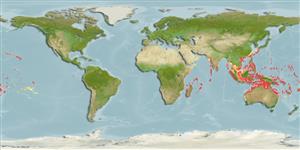Common names from other countries
>
Holocentriformes (Squirrelfishes, soldierfishes) >
Holocentridae (Squirrelfishes, soldierfishes) > Myripristinae
Etymology: Myripristis: Greek, myros, -ou = male of morey eel + Greek, pristis = saw (Ref. 45335).
More on author: Valenciennes.
Environment: milieu / climate zone / depth range / distribution range
Ökologie
seewasser riff-verbunden; tiefenbereich 0 - 100 m (Ref. 128797). Tropical; 32°N - 32°S
Indo-Pacific: East Africa south to Natal, South Africa (except Red Sea, Gulf of Aden, Persian Gulf, Indian coast) and east to French Polynesia and the Hawaiian Islands; north to Tosa Bay, Shikoku (Japan), south to the Great Barrier Reef and Lord Howe Island.
Size / Gewicht / Alter
Maturity: Lm ? range ? - ? cm
Max length : 26.0 cm TL Männchen/unbestimmt; (Ref. 48635); common length : 16.0 cm TL Männchen/unbestimmt; (Ref. 30573)
Rückenflossenstacheln (insgesamt): 11; Rückenflossenweichstrahlen (insgesamt): 15-17; Afterflossenstacheln 4; Afterflossenweichstrahlen: 14 - 16. Body red dorsally, silvery pink below LL; reddish brown bar from upper end of gill opening to base of pectoral fins; fins red except for spinous dorsal which is translucent red basally and broadly yellow distally (Ref. 4201). Has smaller scales than most other similar species and the higher number along the body is quite obvious (Ref. 48635).
Lives in subtidal reef flats, also in lagoon and seaward reefs below the surge zone to depths of at least 26 m. Often occurs in large aggregations during the day in areas of rich foliaceous or cavernous coral growth (Ref. 30573). Benthopelagic (Ref. 58302). Feeds on plankton such as crab larvae. Caught at night (Ref. 30573).
Life cycle and mating behavior
Geschlechtsreife | Fortpflanzung | Ablaichen | Eier | Fecundity | Larven
Randall, J.E. and D.W. Greenfield, 1996. Revision of the Indo-Pacific holocentrid fishes of the genus Myripristis, with descriptions of three new species. Indo-Pac. Fish. (25):61 p. (Ref. 12419)
IUCN Rote Liste Status (Ref. 130435)
CITES (Ref. 128078)
Not Evaluated
Bedrohung für Menschen
Harmless
Nutzung durch Menschen
Fischereien: weniger kommerziell; Aquarium: Kommerziell
Mehr Information
NamenSynonymeMetabolismusRäuberÖkotoxikologieFortpflanzungGeschlechtsreifeAblaichenFecundityEierEientwicklung
ReferenzenAquakulturAquakultur ProfilZuchtlinienGenetikElectrophoresesVererbbarkeitKrankheitenVerarbeitungMass conversion
Tools
Zusatzinformationen
Download XML
Internet Quellen
Estimates based on models
Preferred temperature (Ref.
115969): 25.2 - 28.9, mean 27.8 (based on 640 cells).
Phylogenetic diversity index (Ref.
82804): PD
50 = 0.5000 [Uniqueness, from 0.5 = low to 2.0 = high].
Bayesian length-weight: a=0.02188 (0.01296 - 0.03693), b=3.12 (2.98 - 3.26), in cm Total Length, based on LWR estimates for this species & Genus-body shape (Ref.
93245).
Trophic level (Ref.
69278): 3.4 ±0.2 se; based on diet studies.
Widerstandsfähigkeit (Ref.
120179): hoch, Verdopplung der Population dauert weniger als 15 Monate. (Preliminary K or Fecundity.).
Fishing Vulnerability (Ref.
59153): Low vulnerability (16 of 100).
